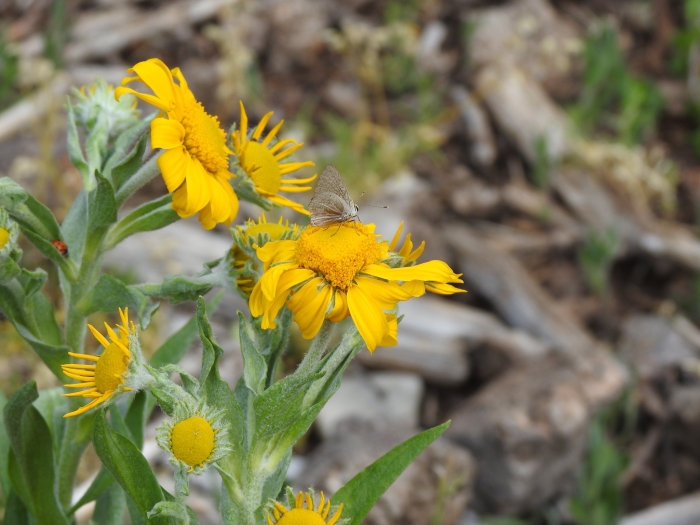Owl’s Claws
(Hymenoxys hoopesii)
Owl’s Claws (Hymenoxys hoopesii)
/
/

CK Kelly
CC BY 4.0
Image By:
CK Kelly
Recorded By:
Copyright:
CC BY 4.0
Copyright Notice:
Photo by: CK Kelly | License Type: CC BY 4.0 | License URL: http://creativecommons.org/licenses/by/4.0/ | Rights Holder: CK Kelly | Publisher: iNaturalist | Date Created: 2019-06-26T22:32:01Z |

























































Estimated Native Range
Summary
Hymenoxys hoopesii, commonly known as Owl’s Claws, is a deciduous perennial herb native to open meadows, grasslands, and mountain clearings in the Western United States, particularly in the Rocky Mountains. It can reach up to a meter (40 inches) in height and is characterized by its smooth-edged leaves, which are oval near the lower stem and become lance-shaped higher up. The plant is notable for its large, showy flowers that bloom in summer and fall, featuring a warm palette of brown, yellow, and red hues. These daisy-like flowers are attractive to pollinators such as bees and butterflies.
Owl’s Claws is valued for its vibrant flowers and ability to adapt to a range of garden settings. It is often used in wildflower gardens, meadow plantings, and as a border plant due to its height and striking floral display. This plant thrives in full sun and requires moderate watering, making it relatively low-maintenance. It is adaptable to various soil types, provided they have good drainage. While generally pest-free, it can be susceptible to root rot if overwatered or planted in poorly drained soils. Owl’s Claws is not known for aggressive roots or significant disease issues, making it a reliable choice for gardeners looking for minimal care requirements.CC BY-SA 4.0
Owl’s Claws is valued for its vibrant flowers and ability to adapt to a range of garden settings. It is often used in wildflower gardens, meadow plantings, and as a border plant due to its height and striking floral display. This plant thrives in full sun and requires moderate watering, making it relatively low-maintenance. It is adaptable to various soil types, provided they have good drainage. While generally pest-free, it can be susceptible to root rot if overwatered or planted in poorly drained soils. Owl’s Claws is not known for aggressive roots or significant disease issues, making it a reliable choice for gardeners looking for minimal care requirements.CC BY-SA 4.0
Plant Description
- Plant Type: Herb
- Height: 1-3 feet
- Width: 1-2 feet
- Growth Rate: Moderate
- Flower Color: Yellow
- Flowering Season: Summer, Fall
- Leaf Retention: Deciduous
Growth Requirements
- Sun: Full Sun
- Water: Medium
- Drainage: Slow, Medium, Fast
Common Uses
Bee Garden, Border Plant, Butterfly Garden, Low Maintenance, Showy Flowers
Natural Habitat
Native to open meadows, grasslands, and mountain clearings in the Western United States, particularly in the Rocky Mountains
Other Names
Common Names: Orange-Sneezeweed, Western-Sneezeweed, Yerba Del Lobo, Gullstake
Scientific Names: , Helenium hoopesii, Hymenoxys hoopesii, Dugaldia hoopesii, Heleniastrum hoopesii,
GBIF Accepted Name: Hymenoxys hoopesii (A.Gray) Bierner